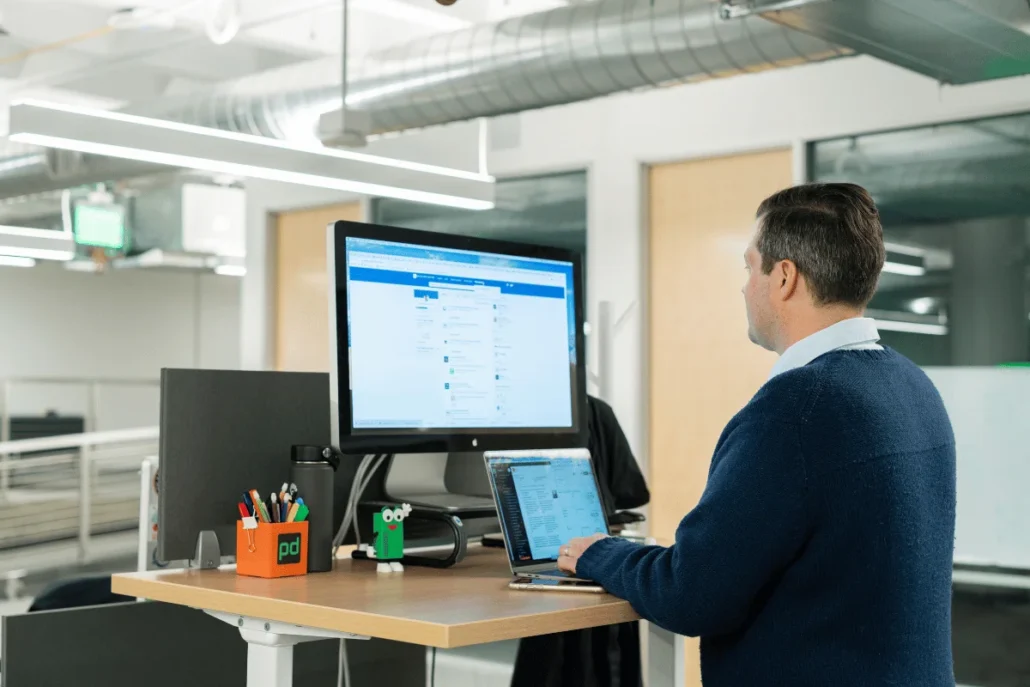Employer Branding on LinkedIn: How to Master Content & Optimize Your Profile
Most LinkedIn users see it as just another social platform. The truth is it’s far more powerful—it’s a search engine for professionals and businesses alike.
When it comes to employer branding, LinkedIn is where you need to focus. As you optimize your presence, you make your brand rise to the top of every relevant search. That’s how you get noticed by the right talent and connections.
But here’s the catch: Your employer brand is a direct reflection of your leadership. Employees and candidates are looking beyond company names. They’re drawn to visible, authentic leadership.
So, a leadership-driven approach to employee branding makes it easier to connect with everyone. That’s why we created this guide as a roadmap to:
- Craft a unified employer and personal brand that cuts through the noise and makes people find you;
- Showcase leadership that will attract the top candidates in your industry to work for your company—not just today but long-term.

What is Employer Branding?
Employer branding is how a company positions itself as an attractive place to work. It’s the ongoing process of defining and promoting your company’s culture, values, and employee experience. It’s shaping how the outside world perceives your organization as a workplace.
Why is Employer Branding Important?
Employer branding directly influences how prospective employees and the public perceive your company.
A strong employer brand helps you:
- Attract top-tier talent
- Reduce turnover
- Boost employee morale
Potential hires want to see your company has a well-defined culture and clear values. Then, they’re more likely to envision themselves as part of your team.
DID YOU KNOW? A Glassdoor survey revealed that, to over half of job seekers, company culture is “more important than salary.” 77% of applicants consider company culture before they apply for a job.
Beyond talent acquisition, employer branding also impacts business reputation. It positions your company as a leader in its industry. In competitive markets, a strong employer brand can be the factor that sets you apart.
At the end of the day, your employer branding is closely connected to your personal brand shining through. You’re the face of your company. And when your values align with its mission, you elevate your reputation and the company’s.
Let’s build a LinkedIn strategy that shapes how peers, clients, and top talent perceive both you and your employer brand. Contact us today!

Benefits of Employer Branding on LinkedIn
LinkedIn is a space where companies strive to build their reputations as desirable employers. A strong employer brand can help you:
- Attract top-tier talent: Showcase your culture and values to draw in the best candidates.
- Increase employee retention: Reinforce loyalty among your team with a consistent, positive brand.
- Enhance thought leadership: Position your company and executives as industry leaders.
- Boost visibility: Engage with consistent, quality content, and the LinkedIn algorithm will reward you.
- Drive business connections: Draw the attention of potential partners who resonate with your brand values.

How to Build a Strong Employer Brand on LinkedIn
Building a powerful employer brand on LinkedIn requires a strategy that:
- Aligns with your business values
- Highlights your culture
- Engages potential employees and partners
Let’s look at what steps you can take to transform your company’s presence on LinkedIn.
Define Your Employer Value Proposition (EVP)
Your EVP is the foundation of your employer brand. It communicates:
- What makes your company unique
- Why employees choose to stay
- Why top talent should join
A well-defined EVP allows you to attract people who align with your mission. LinkedIn is the perfect platform to share this message authentically.
For reference, here’s our EVP at Crackerjack Marketing:
“We’re passionate about empowering executives and corporate teams to build a meaningful presence on LinkedIn. Our teams offer a unique, high-level, hands-on service—no interns or junior marketers involved.
Yes, we’re bold, clever, and edgy. But we’re also experienced, analytical, and approachable. We work hard to make each LinkedIn profile reflect professional excellence and stand out with authenticity and personality. And it brings us tremendous satisfaction.
At Crackerjack Marketing, we attract professionals who value innovation and strategic insight. Within our offices, talent is respected, empowered, and driven by a shared mission to magnetize executive branding.”
Pro Tip:
As an executive, you play a vital role in communicating the EVP to the world. Leverage your personal brand on LinkedIn to show authenticity and commitment to the company values. This way, you’ll make the EVP more relatable and trustworthy.

Audit and Optimize Your LinkedIn Company Page
Your LinkedIn company page is the first touchpoint for many potential candidates.
Conduct a thorough audit to ensure it:
- Reflects your EVP
- Features up-to-date information
- Showcases your culture
Optimize your page with a clear company description and compelling visuals. Equally important, update it consistently to keep your audience engaged.
Create a LinkedIn Content Strategy
A winning content formula is essential for building a brand that resonates with your ideal audience. Plan and schedule regular posts that reflect your company’s culture, leadership, and industry expertise.
The goal of your content strategy for LinkedIn is to engage your audience and build credibility. So, use a mix of thought leadership, company news, and employee success stories.
Once again, as an executive, you can further enhance this by sharing thought leadership that ties back to your company’s mission. Leaders who consistently promote the company’s vision and values will attract top talent and partners who align with it.
Enhance Your LinkedIn Career Page
A dedicated LinkedIn Career Page allows you to highlight job opportunities. It also provides a window into your company culture.
Customize this page to align with your EVP and feature employee testimonials. Whenever showing off your workplace, do your best to be genuine but add a dash of reliability.

Use Employee-Generated Content and Stories
Authentic, employee-generated content resonates more with prospective hires. Plus, it builds trust by showing what it’s truly like to work at your company. That’s why you want to let your employees be your best ambassadors.
From executives to individual contributors, everyone can strengthen your brand by actively managing their LinkedIn profiles. When they share insights and engage with relevant content, they:
- Amplify the company’s mission and values
- Boost visibility and credibility
So, by all means, encourage them to share their experiences, stories, and achievements on LinkedIn.
Leverage LinkedIn Jobs and Recruiter Tools
LinkedIn offers powerful recruitment tools that can amplify your employer brand.
LinkedIn Jobs is great for reaching a wider pool of candidates. Similarly, LinkedIn Recruiter allows you to connect directly with top talent. These tools will:
- Help you build relationships with potential hires
- Showcase your company as a place where they want to work
Boost Visibility With Ads and Sponsored Content
Paid LinkedIn campaigns, like ads and sponsored content, significantly boost your visibility—brands that advertise here can see a 2-3x lift in brand attributes.
By promoting your employer brand through targeted ads, you can reach the right audience—job seekers or industry professionals. Similarly, sponsored content helps you:
- Build awareness
- Attract top talent
- Increase engagement with your company’s updates

Use LinkedIn Video Content
Video content has become one of LinkedIn’s most engaging formats. According to Sprout Social:
- Videos are getting 5x more engagement on the platform
- Users engage with video ads nearly 3x longer than with other ad types
For employee branding, video helps potential candidates understand your company’s culture and values. It makes them more likely to connect with your mission.
So, share behind-the-scenes footage, employee testimonials, and video leadership insights as often as possible.
Pro Tip: AI video makers like Synthesia are excellent employer branding resources. You can use them to create personal avatars (digital doubles) for your top management.
These avatars deliver any text message as a professional video, saving you from the hassle of filming or editing. Here’s a video that explains how personal avatars work:
Encourage Prompt Employees to Share Experiences
Encourage employees to post about their experiences, projects, and day-to-day work on LinkedIn.
Prompt them to engage with the company page and share positive experiences. This helps humanize your brand and strengthens trust among prospective candidates.
Manage Comments and Actively Participate in Conversations
Engagement is key to building a vibrant employer brand. To foster it, monitor and respond to all the positive and negative comments you receive.
Actively participate in LinkedIn conversations to:
- Demonstrate your company’s culture of openness and responsiveness
- Create opportunities to build relationships with potential hires and industry influencers

LinkedIn Employer Branding Examples
Seeing how other companies successfully build their employer brand on LinkedIn can offer valuable insights. Let’s look at two examples that stand out:
1. Adobe
With 5M followers on LinkedIn, Adobe is quite a popular brand with an inclusive and engaging vibe. Its company page consistently shares employee stories, behind-the-scenes content, and diversity initiatives. And the visually appealing posts attract a wide range of talent.
2. HubSpot
Despite a smaller following of “only” 1M users, HubSpot is another prevalent brand on the platform. Typically, it mixes employee-generated content with executive thought leadership. Highlighting workplace achievements and transparency offers a clear view of the company’s culture and employee growth opportunities.
DID YOU KNOW?
Adobe and Hubspot actively promote personal branding among their leadership and employees. Why? Because leaders who engage in industry conversations become trusted voices in their field. And that trust extends to the companies they represent.
That’s why LinkedIn is the go-to platform for executives. Building your personal brand here is both a career move and a strategic business advantage.
Let’s connect and discuss how our senior-level marketers can guide you in building a LinkedIn presence that:
- Amplifies your personal brand and influence
- Drives measurable growth for your business

Common Mistakes to Avoid in Your Employer Branding Strategy
Even with the best intentions, companies can make mistakes when building their employer brand on LinkedIn. That’s bad because missteps can weaken a brand’s credibility, making it harder to attract the right talent.
The good news? These mistakes are avoidable as long as you’re aware of them. Here are a few common pitfalls to watch out for:
- Inconsistent messaging: Mixed signals on values and culture can confuse potential candidates.
- Neglecting the company page: An outdated or inactive page sends the wrong message.
- Ignoring employee input: Failing to include employee voices weakens authenticity.
- Focusing solely on recruitment: Employer branding should also reflect company culture and leadership.
- Overlooking engagement: Not responding to comments or engaging with your audience reduces trust.

Best Practices for Employer Branding on LinkedIn
You need more than a strong profile to build a compelling employer brand on LinkedIn. You have to be authentic in your interactions, encouraging meaningful engagement. Here are some key best practices to follow:
- Stay consistent with your message: Ensure alignment between your company’s values, culture, and content.
- Showcase employee stories: Highlight real experiences to bring authenticity to your brand.
- Engage regularly: Respond to comments, engage with your network, and participate in conversations.
- Use multimedia content: Incorporate videos and images to make your posts more engaging and relatable.
- Measure your impact: Use LinkedIn analytics to track the effectiveness of your employer branding strategy.

Frequently Asked Questions (FAQs)
Employer branding on LinkedIn can feel complex, especially when integrating it with other strategies. These answers to some of the most common questions will help you refine your approach:
How Can You Integrate LinkedIn Employer Branding With Other Platforms?
Consistency is key. Wherever you post, maintain a consistent core message but adapt it to fit each platform’s audience.
On LinkedIn, focus on professional and thought-leadership content. On platforms like Twitter, Instagram, or Facebook, highlight culture, employee stories, and more casual insights.
For a unified brand experience, tone, visuals, and overall branding should align across all channels.
What Are the Most Effective Employer Branding Tools Available?
Tools like LinkedIn Analytics, Hootsuite, and Buffer help manage your posts and track engagement.
Canva for design and Synthesia or Lumen5 for video creation can make your employer brand content more engaging.
How Often Should You Post Employer Branding Content on LinkedIn?
Aim to post at least 2-3 times per week. Consistency is key to keeping your brand visible and engaging without overwhelming your audience.
Mix up content types, including posts, videos, and employee stories, to maintain variety and engagement.
What Are the Key Differences Between Personal Branding and Employer Branding on LinkedIn?
Personal and employer branding differ in terms of tone, focus, objectives, and impact. They can coexist. Still, at their core:
- Personal branding focuses on individual thought leadership and career development. It’s more about the individual.
- Employer branding highlights the company culture, values, and what makes the business an attractive place to work. It’s more about the company’s collective identity.
Conclusion – How to Improve Employer Branding
LinkedIn employer branding best practices involve a bold mix of authenticity, consistent messaging, and active engagement. Small, uniform efforts can lead to a significant impact over time.
To solidify a brand that serves your company’s reputation and attracts top talent, you must:
- Define your company values
- Show employee experiences
- Leverage LinkedIn’s tools
But here’s the key takeaway: Your employer brand reflects your leadership. Want an authentic presence that resonates with talent and industry peers? Align your personal brand with your company’s values.
Not sure where to begin? Contact us at Crackerjack Marketing. We’ll guide you to manage your own LinkedIn account, amplify thought leadership, and grow your company’s reputation.
She’s been in social media for over 20 years, and teaches digital marketing at universities in Barcelona and Bangkok.
Follow her on LinkedIn
for expert LinkedIn and marketing advice.
STEPHANIE SCHWAB
CEO & Founder
Stephanie is the Founder and CEO of Crackerjack Marketing.
She’s been in social media for over 20 years, and teaches digital marketing at universities in Barcelona and Bangkok.
Follow her on LinkedIn
for expert LinkedIn and marketing advice.
Categories
Employer Branding on LinkedIn: How to Master Content & Optimize Your Profile
Most LinkedIn users see it as just another social platform. The truth is it’s far more powerful—it’s a search engine for professionals and businesses alike.
When it comes to employer branding, LinkedIn is where you need to focus. As you optimize your presence, you make your brand rise to the top of every relevant search. That’s how you get noticed by the right talent and connections.
But here’s the catch: Your employer brand is a direct reflection of your leadership. Employees and candidates are looking beyond company names. They’re drawn to visible, authentic leadership.
So, a leadership-driven approach to employee branding makes it easier to connect with everyone. That’s why we created this guide as a roadmap to:
- Craft a unified employer and personal brand that cuts through the noise and makes people find you;
- Showcase leadership that will attract the top candidates in your industry to work for your company—not just today but long-term.

What is Employer Branding?
Employer branding is how a company positions itself as an attractive place to work. It’s the ongoing process of defining and promoting your company’s culture, values, and employee experience. It’s shaping how the outside world perceives your organization as a workplace.
Why is Employer Branding Important?
Employer branding directly influences how prospective employees and the public perceive your company.
A strong employer brand helps you:
- Attract top-tier talent
- Reduce turnover
- Boost employee morale
Potential hires want to see your company has a well-defined culture and clear values. Then, they’re more likely to envision themselves as part of your team.
DID YOU KNOW? A Glassdoor survey revealed that, to over half of job seekers, company culture is “more important than salary.” 77% of applicants consider company culture before they apply for a job.
Beyond talent acquisition, employer branding also impacts business reputation. It positions your company as a leader in its industry. In competitive markets, a strong employer brand can be the factor that sets you apart.
At the end of the day, your employer branding is closely connected to your personal brand shining through. You’re the face of your company. And when your values align with its mission, you elevate your reputation and the company’s.
Let’s build a LinkedIn strategy that shapes how peers, clients, and top talent perceive both you and your employer brand. Contact us today!

Benefits of Employer Branding on LinkedIn
LinkedIn is a space where companies strive to build their reputations as desirable employers. A strong employer brand can help you:
- Attract top-tier talent: Showcase your culture and values to draw in the best candidates.
- Increase employee retention: Reinforce loyalty among your team with a consistent, positive brand.
- Enhance thought leadership: Position your company and executives as industry leaders.
- Boost visibility: Engage with consistent, quality content, and the LinkedIn algorithm will reward you.
- Drive business connections: Draw the attention of potential partners who resonate with your brand values.

How to Build a Strong Employer Brand on LinkedIn
Building a powerful employer brand on LinkedIn requires a strategy that:
- Aligns with your business values
- Highlights your culture
- Engages potential employees and partners
Let’s look at what steps you can take to transform your company’s presence on LinkedIn.
Define Your Employer Value Proposition (EVP)
Your EVP is the foundation of your employer brand. It communicates:
- What makes your company unique
- Why employees choose to stay
- Why top talent should join
A well-defined EVP allows you to attract people who align with your mission. LinkedIn is the perfect platform to share this message authentically.
For reference, here’s our EVP at Crackerjack Marketing:
“We’re passionate about empowering executives and corporate teams to build a meaningful presence on LinkedIn. Our teams offer a unique, high-level, hands-on service—no interns or junior marketers involved.
Yes, we’re bold, clever, and edgy. But we’re also experienced, analytical, and approachable. We work hard to make each LinkedIn profile reflect professional excellence and stand out with authenticity and personality. And it brings us tremendous satisfaction.
At Crackerjack Marketing, we attract professionals who value innovation and strategic insight. Within our offices, talent is respected, empowered, and driven by a shared mission to magnetize executive branding.”
Pro Tip:
As an executive, you play a vital role in communicating the EVP to the world. Leverage your personal brand on LinkedIn to show authenticity and commitment to the company values. This way, you’ll make the EVP more relatable and trustworthy.

Audit and Optimize Your LinkedIn Company Page
Your LinkedIn company page is the first touchpoint for many potential candidates.
Conduct a thorough audit to ensure it:
- Reflects your EVP
- Features up-to-date information
- Showcases your culture
Optimize your page with a clear company description and compelling visuals. Equally important, update it consistently to keep your audience engaged.
Create a LinkedIn Content Strategy
A winning content formula is essential for building a brand that resonates with your ideal audience. Plan and schedule regular posts that reflect your company’s culture, leadership, and industry expertise.
The goal of your content strategy for LinkedIn is to engage your audience and build credibility. So, use a mix of thought leadership, company news, and employee success stories.
Once again, as an executive, you can further enhance this by sharing thought leadership that ties back to your company’s mission. Leaders who consistently promote the company’s vision and values will attract top talent and partners who align with it.
Enhance Your LinkedIn Career Page
A dedicated LinkedIn Career Page allows you to highlight job opportunities. It also provides a window into your company culture.
Customize this page to align with your EVP and feature employee testimonials. Whenever showing off your workplace, do your best to be genuine but add a dash of reliability.

Use Employee-Generated Content and Stories
Authentic, employee-generated content resonates more with prospective hires. Plus, it builds trust by showing what it’s truly like to work at your company. That’s why you want to let your employees be your best ambassadors.
From executives to individual contributors, everyone can strengthen your brand by actively managing their LinkedIn profiles. When they share insights and engage with relevant content, they:
- Amplify the company’s mission and values
- Boost visibility and credibility
So, by all means, encourage them to share their experiences, stories, and achievements on LinkedIn.
Leverage LinkedIn Jobs and Recruiter Tools
LinkedIn offers powerful recruitment tools that can amplify your employer brand.
LinkedIn Jobs is great for reaching a wider pool of candidates. Similarly, LinkedIn Recruiter allows you to connect directly with top talent. These tools will:
- Help you build relationships with potential hires
- Showcase your company as a place where they want to work
Boost Visibility With Ads and Sponsored Content
Paid LinkedIn campaigns, like ads and sponsored content, significantly boost your visibility—brands that advertise here can see a 2-3x lift in brand attributes.
By promoting your employer brand through targeted ads, you can reach the right audience—job seekers or industry professionals. Similarly, sponsored content helps you:
- Build awareness
- Attract top talent
- Increase engagement with your company’s updates

Use LinkedIn Video Content
Video content has become one of LinkedIn’s most engaging formats. According to Sprout Social:
- Videos are getting 5x more engagement on the platform
- Users engage with video ads nearly 3x longer than with other ad types
For employee branding, video helps potential candidates understand your company’s culture and values. It makes them more likely to connect with your mission.
So, share behind-the-scenes footage, employee testimonials, and video leadership insights as often as possible.
Pro Tip: AI video makers like Synthesia are excellent employer branding resources. You can use them to create personal avatars (digital doubles) for your top management.
These avatars deliver any text message as a professional video, saving you from the hassle of filming or editing. Here’s a video that explains how personal avatars work:
Encourage Prompt Employees to Share Experiences
Encourage employees to post about their experiences, projects, and day-to-day work on LinkedIn.
Prompt them to engage with the company page and share positive experiences. This helps humanize your brand and strengthens trust among prospective candidates.
Manage Comments and Actively Participate in Conversations
Engagement is key to building a vibrant employer brand. To foster it, monitor and respond to all the positive and negative comments you receive.
Actively participate in LinkedIn conversations to:
- Demonstrate your company’s culture of openness and responsiveness
- Create opportunities to build relationships with potential hires and industry influencers

LinkedIn Employer Branding Examples
Seeing how other companies successfully build their employer brand on LinkedIn can offer valuable insights. Let’s look at two examples that stand out:
1. Adobe
With 5M followers on LinkedIn, Adobe is quite a popular brand with an inclusive and engaging vibe. Its company page consistently shares employee stories, behind-the-scenes content, and diversity initiatives. And the visually appealing posts attract a wide range of talent.
2. HubSpot
Despite a smaller following of “only” 1M users, HubSpot is another prevalent brand on the platform. Typically, it mixes employee-generated content with executive thought leadership. Highlighting workplace achievements and transparency offers a clear view of the company’s culture and employee growth opportunities.
DID YOU KNOW?
Adobe and Hubspot actively promote personal branding among their leadership and employees. Why? Because leaders who engage in industry conversations become trusted voices in their field. And that trust extends to the companies they represent.
That’s why LinkedIn is the go-to platform for executives. Building your personal brand here is both a career move and a strategic business advantage.
Let’s connect and discuss how our senior-level marketers can guide you in building a LinkedIn presence that:
- Amplifies your personal brand and influence
- Drives measurable growth for your business

Common Mistakes to Avoid in Your Employer Branding Strategy
Even with the best intentions, companies can make mistakes when building their employer brand on LinkedIn. That’s bad because missteps can weaken a brand’s credibility, making it harder to attract the right talent.
The good news? These mistakes are avoidable as long as you’re aware of them. Here are a few common pitfalls to watch out for:
- Inconsistent messaging: Mixed signals on values and culture can confuse potential candidates.
- Neglecting the company page: An outdated or inactive page sends the wrong message.
- Ignoring employee input: Failing to include employee voices weakens authenticity.
- Focusing solely on recruitment: Employer branding should also reflect company culture and leadership.
- Overlooking engagement: Not responding to comments or engaging with your audience reduces trust.

Best Practices for Employer Branding on LinkedIn
You need more than a strong profile to build a compelling employer brand on LinkedIn. You have to be authentic in your interactions, encouraging meaningful engagement. Here are some key best practices to follow:
- Stay consistent with your message: Ensure alignment between your company’s values, culture, and content.
- Showcase employee stories: Highlight real experiences to bring authenticity to your brand.
- Engage regularly: Respond to comments, engage with your network, and participate in conversations.
- Use multimedia content: Incorporate videos and images to make your posts more engaging and relatable.
- Measure your impact: Use LinkedIn analytics to track the effectiveness of your employer branding strategy.

Frequently Asked Questions (FAQs)
Employer branding on LinkedIn can feel complex, especially when integrating it with other strategies. These answers to some of the most common questions will help you refine your approach:
How Can You Integrate LinkedIn Employer Branding With Other Platforms?
Consistency is key. Wherever you post, maintain a consistent core message but adapt it to fit each platform’s audience.
On LinkedIn, focus on professional and thought-leadership content. On platforms like Twitter, Instagram, or Facebook, highlight culture, employee stories, and more casual insights.
For a unified brand experience, tone, visuals, and overall branding should align across all channels.
What Are the Most Effective Employer Branding Tools Available?
Tools like LinkedIn Analytics, Hootsuite, and Buffer help manage your posts and track engagement.
Canva for design and Synthesia or Lumen5 for video creation can make your employer brand content more engaging.
How Often Should You Post Employer Branding Content on LinkedIn?
Aim to post at least 2-3 times per week. Consistency is key to keeping your brand visible and engaging without overwhelming your audience.
Mix up content types, including posts, videos, and employee stories, to maintain variety and engagement.
What Are the Key Differences Between Personal Branding and Employer Branding on LinkedIn?
Personal and employer branding differ in terms of tone, focus, objectives, and impact. They can coexist. Still, at their core:
- Personal branding focuses on individual thought leadership and career development. It’s more about the individual.
- Employer branding highlights the company culture, values, and what makes the business an attractive place to work. It’s more about the company’s collective identity.
Conclusion – How to Improve Employer Branding
LinkedIn employer branding best practices involve a bold mix of authenticity, consistent messaging, and active engagement. Small, uniform efforts can lead to a significant impact over time.
To solidify a brand that serves your company’s reputation and attracts top talent, you must:
- Define your company values
- Show employee experiences
- Leverage LinkedIn’s tools
But here’s the key takeaway: Your employer brand reflects your leadership. Want an authentic presence that resonates with talent and industry peers? Align your personal brand with your company’s values.
Not sure where to begin? Contact us at Crackerjack Marketing. We’ll guide you to manage your own LinkedIn account, amplify thought leadership, and grow your company’s reputation.
Search our Blog
Get our Free Editorial Calendar Template.
Are you stressed out by the time it takes to create great content?
In this handy Google Doc, which you can save and use on your own, you’ll get a super-simple layout to guide your content creation and management efforts.
DOWNLOAD TODAY
STEPHANIE SCHWAB
CEO & Founder
Stephanie founder and CEO of Crackerjack Marketing.
She’s been in social media for over 20 years, and teaches digital marketing at universities in Barcelona and Bangkok.
Follow her on LinkedIn
for expert LinkedIn and marketing advice.
Create your own spark
Join 5,000+ marketers who receive our B2B marketing ideas and insights each week.
Join 5,000+ marketers who receive our B2B marketing ideas and insights each week.
Who We Serve
Company
Who We Are
Our Services
Blog
Free Editorial Calendar Template
Work With Us
Resources
Chicago, Barcelona, Mumbai
1055 W. Bryn Mawr Suite F-196
Chicago, IL 60660
+1-312-429-5588
Headquarters:
© Copyright 2025 Kyle Partners, LLC, d/b/a Crackerjack Marketing. All rights reserved. | Terms of Service | Privacy Policy